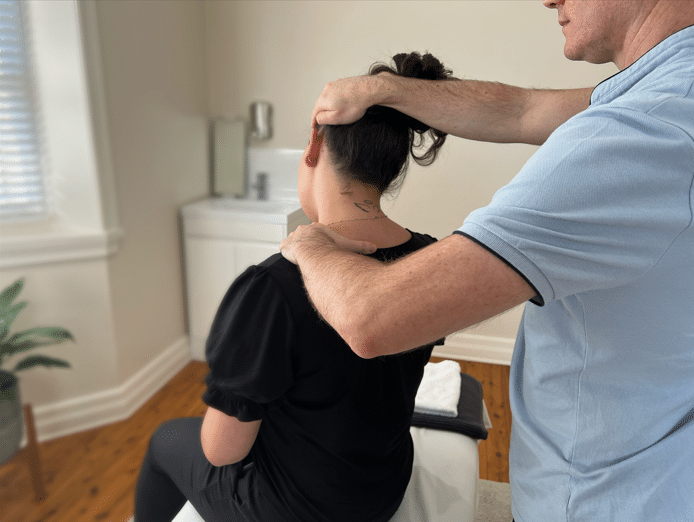- 02 9712 1736
- [email protected]
- 212 Great North Road, Five Dock, NSW 2046
- Open 7 days a week
Neck and back pain may be caused by a variety of reasons. In this post, we will take a deeper look at one of these reasons – facet joint syndrome. As the name suggests, facet joint syndrome involves irritation and inflammation of the facet joints. These are joints in your spine that connect the different vertebral segments together while still allowing for movement in the spine. Facet joint syndrome can be a source of daily discomfort and, at its worst, can result in significant pain, preventing activity. In this post, we aim to provide a comprehensive understanding of this condition, covering its symptoms, causes, diagnosis, and treatment options.

Facet joint syndrome occurs as a result of irritation and inflammation of the facet joints. The facet joints are small joints that are positioned on either side and towards the back of each vertebra segment. They allow for movement of each vertebra with the vertebra above and below. They play a crucial role in providing stability while facilitating movement. Irritation and inflammation of the facet joins can often be accompanied by pain and stiffness.
Facet joint syndrome is often associated with specific pain over the facet joint, with radiating pain and muscle spasms that develop when left untreated. Pain can significantly impair mobility, so it is important to seek treatment as soon as possible to prevent exacerbation of this condition.
The spine is made up of multiple bones called vertebra that are stacked one on top of the other forming a column. Individual vertebrae is connected to the vertebrae above and below via facet joints. These joints are position towards the back of the vertebrae, and on either side. Facet joints, like most other joints in your body, are synovial joints, with synovial cartilages at the end of the bones to prevent friction between the bony ends as they move, synovial fluid within each joint for lubrication purposes, and synovial capsules which encloses each joint and hold them together. The facet joints have important roles in stability and shock absorption, while maintaining mobility in your spine, allowing you to bend and twist.


Facet joint syndrome is caused by irritation and inflammation of the facet joints. So how then do facet joints become irritated? A common mechanism for facet joint irritation is abrupt facet joint compression in spinal extension, usually under load. This compression or jamming of the facet joint results in irritation which initiates the process of inflammation and muscle guarding to prevent further irritation.
Another reason facet joint syndrome can develop is degeneration. As we age, the cartilage that cushions the facet joints naturally wears down, leading to pain and dysfunction. This degeneration is often exacerbated by repetitive movements and poor posture, which place additional strain on the joints, potentially developing facet joint osteoarthritis. Associated conditions such as degenerative disc disease can increase pressure on the facet joints, accelerating cartilage breakdown and contributing to the development of facet joint syndrome.
Obesity is another significant risk factor, as excess body weight places increased physical stress on the joints, leading to faster degeneration.
Grasping these causes is pivotal for preventing and managing facet joint syndrome. Addressing factors like posture, weight management, and avoiding repetitive strain can reduce the risk of developing this painful condition. Recognizing the signs early and seeking appropriate treatment can also help mitigate the impact of facet joint syndrome on daily life.
Facet joint syndrome often begins with a dull ache in the lower back, which can escalate into localized pain on one side of the lower back and thigh. In the cervical region, the pain may radiate into the shoulders and the back of the skull, while in the lumbar region, it can spread to the buttock, groin, thighs, and knee. This radiating pain is a key indicator of facet joint involvement.
Muscles near the irritated facet joint may stiffen and spasm, leading to further discomfort and reduced mobility. The pain is typically worse in the morning, after periods of inactivity, or with spine extension. These symptoms can vary in intensity and duration, often presenting as a chronic condition with intermittent flare-ups. Recognizing these symptoms is key to differentiating facet joint pain from other spinal issues.

A thorough evaluation by a pain physician is the first step, where the patient’s symptoms, medical history, and physical examination results are carefully reviewed to diagnose facet joint pain. Information such as pain reproducing activity and pain behaviour can provide valuable insights in the diagnosis making process. This comprehensive approach helps in identifying the source of pain and planning appropriate interventions.
Accurate diagnosis is critical, as the symptoms of facet joint syndrome can mimic those of other conditions, such as degenerative disc disease or nerve root impingement. Recognizing the specific patterns of pain and stiffness associated with facet joint syndrome enables healthcare providers to isolate the condition and develop an effective treatment plan.
Patient history is a vital component in diagnosing facet joint pain, providing valuable insights into the nature and onset of symptoms. During consultations, doctors focus on the specifics of the pain, including when it started, how long it has lasted, and any related medical history. These details are crucial for guiding further assessments and determining the most effective treatment approach.

During the physical examination, doctors assess posture and perform palpation to identify areas of tenderness and inflammation. They also conduct range of motion tests to evaluate the mobility and flexibility of the spine, which can indicate facet joint involvement. These tests often include flexion, extension, lateral bending, and rotation to pinpoint the movements that exacerbate the pain.
A physical examination is essential for identifying areas affected by facet joint syndrome and ruling out other potential causes of joint pain. This hands-on approach helps healthcare providers develop a more accurate diagnosis and tailor treatment plans to the individual needs of the patient.

Imaging tests can be useful in diagnosing facet joint syndrome but is usually not necessary. Imaging tests allow healthcare providers to visualise the joint structure and identify abnormalities in the region being imaged. X-rays can reveal bony changes associated with degeneration, such as bone spurs, that may be affecting the facet joints. However, they would likely not provide additional useful information beyond indicating inflammation in the facet joints. An MRI can be performed to also visualise soft tissue structures in the area of pain to assess for damage to soft tissue structures like ligaments should treatment for facet joint syndrome fail to produce results.
Conservative management is typically recommended in the management of facet joint syndrome. Read on below to understand the approach that is taken when it comes to conservative treatment.
Should conservative management prove to be ineffective, some interventional strategies may be considered to manage symptoms.

Conservative management methods are the first line of treatment for facet joint pain, focusing on non-surgical approaches to provide relief. A combination of physical therapy, activity changes, self-care exercises, and non-steroidal anti-inflammatory medications such ibuprofen is used to restore biomechanical function while reducing pain levels. Physical therapy is especially important to restore function while addressing inflammation to alleviate pain and reduce the strain on facet joints. Advice concerning posture and activities to avoid can help reduce pain exacerbation. With reduction of pain, exercises will be given to help rehabilitate movement pattern and reduce the chances of developing compensatory movement patterns. If these conservative methods do not provide sufficient relief, further imaging may be recommended to ascertain diagnosis.
If pain persists despite extended period of conservative management, corticosteroid injection may be recommended. This involves administering steroids into the area of inflammation to reduce inflammation and provide pain relief. These injections are minimally invasive and can offer short to intermediate-term relief.

Physical therapy plays a crucial role in managing facet joint pain, helping to strengthen the spine and reduce stress on the affected joints. A structured physical therapy program often includes manual therapy, stretching and strengthening exercises to facilitate recovery and prevent recurrence of future injury. Exercises focus on improving mobility and building strength and stability to support the spine. With reduction of pain, your physical therapist may also want to work on improving your movement pattern and function to prevent future reinjury.
Regular physical therapy has the added benefit of preventing facet joint syndrome and other musculoskeletal aches and pains. Engaging in regular physical therapy can be beneficial to spinal health. Here are some reasons why:
Optimal Function: Ensuring that your muscles and joints are functioning optimally – retaining their maximal range of movement and flexibility – means that you are less likely to stress your body and end up with an injury.
Proper Posture: Maintaining good posture can be difficult when your muscles and joints are tight and stiff from bad postural habits. Physical therapy can help you improve your posture and in doing so, help you avoid placing unnecessary stress on your body and risking injury while performing activities that you love.
Proper Movement: Your physical therapist will provide you with advice concerning how you should be moving and how you may be moving incorrectly. Learning to avoid compensatory mechanism of movement will signficantly reduce the likelihood of injury.
Facet joint syndrome can be a complex and often debilitating condition. Understanding its symptoms, causes, and treatment options can be helpful. By recognizing the symptoms, seeking appropriate medical care, and adopting preventive measures, you can significantly reduce the time required for recovery and improve your quality of life.
Conservative management is generally recommended for recovery, with continued physical therapy being recommended for optimal musculoskeletal and spinal health. Proper posture, proper movement, and regular exercise is key when it comes to preventing facet joint syndrome.

Forest Lodge, Annandale, Glebe, Leichhardt, Balmain, Haberfield, Canada Bay, Rozelle, Rodd Point, Wareemba, Stanmore, Petersham, Lilyfield, Hunters Hill, Enfield, Cabarita, Mortlake, Rhodes, Burwood Heights, Birchgrove, Gladesville, Huntleys Point, Abbotsford, Ashfield, Croydon Park, Croydon, Chiswick, Russell Lea, Burwood, Strathfield, Concord, Drummoyne, North Strathfield, Liberty Grove, Dulwich Hill, Lewisham, Camperdown, Ashbury, Homebush, Homebush West, Woolwich, Henley, Summer Hill, Sydney Olympic Park


About
Five Dock Osteopathic & Chiropractic is located in Canada Bay, in Sydney’s Inner West. Servicing suburbs including Burwood, Croydon, Drummoyne, Five Dock, Haberfield, Concord, Abbotsford, Chiswick, Leichhardt, Wareemba, Russell Lea, Summer Hill, Strathfield.
Clinic hours
Monday, Tuesday, Thursday 7AM – 7PM
Wednesday, Friday 7AM – 6PM
Saturday 7AM – 2PM
Sunday 8AM – 2PM
Contact details